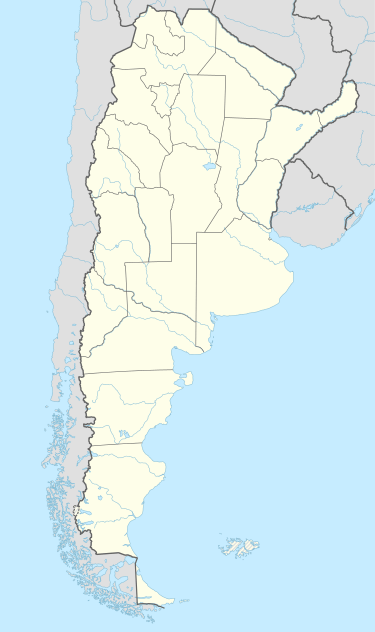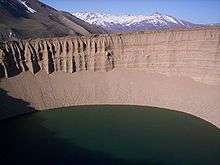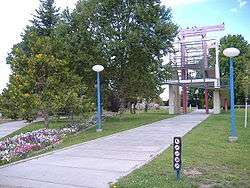Malargüe
| Malargüe | |
|---|---|
| City | |
|
Plaza San Martin | |
 Malargüe Location of Malargüe in Argentina | |
| Coordinates: 35°28.5′S 69°35′W / 35.4750°S 69.583°WCoordinates: 35°28.5′S 69°35′W / 35.4750°S 69.583°W | |
| Country | Argentina |
| Province | Mendoza |
| Department | Malargüe |
| Elevation | 1,402 m (4,600 ft) |
| Population | |
| • Total | 23,020 |
| Time zone | ART (UTC-3) |
| CPA base | M5613 |
| Dialing code | +54 2627 |
| Climate | BSk |
Malargüe (Spanish pronunciation: [maˈlarɣwe]) is a city in the southwest part of province of Mendoza, Argentina, about 370 km south of the provincial capital Mendoza. It is the head town of the Malargüe Department, and it has about 23,000 inhabitants as per the 2001 census [INDEC].
Overview
The city is located in a semi-arid area. Agriculture is focused on the production of seed potato, along with minor crops such as alfalfa, onion and garlic. In the past, the local industries included oil exploration and production (now almost completely deactivated) and uranium mining. As a touristic area, Malargüe provides hotels and cabins for visitors interested in eco-tourism in the summer and skiing in the winter at the nearby resorts of Las Leñas and Los Molles.
The city is known for its traditional dish, the chivito (baby goat). It hosts the annual National Festival of the Goat and the Provincial Festival of the Lamb, during the second week of January.
 Clock tower in the city center
Clock tower in the city center Las Animas well
Las Animas well
History
1972
On 13 October 1972 the Uruguayan Air Force Flight 571 crashed in the Andes, in the municipal territory of Malargüe (34°45′54″S 70°17′11″W / 34.76500°S 70.28639°W).
Climate
Malargüe's climate is dry and relatively cold. Summers bring warm days (the average is 28 °C, or 82F) and cool to cold nights (11 °C, or 53F), with sporadic thunderstorms occurring. By March or early April, frost is to be expected, and during the winter (May to September), wild fluctuations of temperature can occur: the average high is 11 °C (53F) and the average low is -2 °C (28F), but northwesterly winds that blow downslope from the Andes can bring temperatures of 25 °C (77F), and extreme Antarctic outbreaks will bring periods of snow, daytime highs well below 0 °C (32F) and night lows well below -12 °C (10F). Temperatures have reached lows of -23 °C (-9F) in the past.
| Climate data for Malargüe, Mendoza, Argentina (1961–1990, extremes 1970–present) | |||||||||||||
|---|---|---|---|---|---|---|---|---|---|---|---|---|---|
| Month | Jan | Feb | Mar | Apr | May | Jun | Jul | Aug | Sep | Oct | Nov | Dec | Year |
| Record high °C (°F) | 36.7 (98.1) |
35.2 (95.4) |
33.6 (92.5) |
30.6 (87.1) |
27.8 (82) |
27.4 (81.3) |
28.5 (83.3) |
29.4 (84.9) |
31.0 (87.8) |
30.8 (87.4) |
33.5 (92.3) |
36.5 (97.7) |
36.7 (98.1) |
| Average high °C (°F) | 27.9 (82.2) |
26.9 (80.4) |
23.7 (74.7) |
19.7 (67.5) |
15.3 (59.5) |
11.5 (52.7) |
10.9 (51.6) |
13.4 (56.1) |
16.2 (61.2) |
20.1 (68.2) |
23.7 (74.7) |
26.6 (79.9) |
19.7 (67.5) |
| Daily mean °C (°F) | 19.6 (67.3) |
18.4 (65.1) |
15.3 (59.5) |
11.3 (52.3) |
7.4 (45.3) |
4.2 (39.6) |
3.5 (38.3) |
5.4 (41.7) |
8.1 (46.6) |
12.1 (53.8) |
15.6 (60.1) |
18.4 (65.1) |
11.6 (52.9) |
| Average low °C (°F) | 10.7 (51.3) |
10.0 (50) |
7.9 (46.2) |
4.1 (39.4) |
0.9 (33.6) |
−1.7 (28.9) |
−2.5 (27.5) |
−1.4 (29.5) |
0.5 (32.9) |
3.9 (39) |
6.8 (44.2) |
9.6 (49.3) |
4.1 (39.4) |
| Record low °C (°F) | 0.3 (32.5) |
−1.3 (29.7) |
−2.9 (26.8) |
−6.9 (19.6) |
−12.0 (10.4) |
−13.7 (7.3) |
−24.6 (−12.3) |
−15.6 (3.9) |
−10.1 (13.8) |
−5.4 (22.3) |
−3.8 (25.2) |
−0.9 (30.4) |
−24.6 (−12.3) |
| Average precipitation mm (inches) | 24.0 (0.945) |
29.5 (1.161) |
24.5 (0.965) |
14.5 (0.571) |
21.1 (0.831) |
35.0 (1.378) |
36.9 (1.453) |
16.1 (0.634) |
21.1 (0.831) |
19.4 (0.764) |
22.1 (0.87) |
26.6 (1.047) |
290.8 (11.449) |
| Average precipitation days (≥ 0.1 mm) | 4 | 5 | 5 | 3 | 4 | 5 | 5 | 4 | 5 | 4 | 4 | 4 | 52 |
| Average snowy days | 0 | 0 | 0 | 0 | 0.8 | 2 | 3 | 1 | 2 | 0.3 | 0.1 | 0 | 9.2 |
| Average relative humidity (%) | 48 | 54 | 61 | 64 | 66 | 69 | 70 | 63 | 56 | 51 | 47 | 47 | 58 |
| Mean monthly sunshine hours | 328.6 | 257.1 | 254.2 | 213.0 | 192.2 | 150.0 | 151.9 | 170.5 | 162.0 | 220.1 | 294.0 | 322.4 | 2,716 |
| Percent possible sunshine | 73 | 68 | 66 | 63 | 60 | 51 | 48 | 51 | 45 | 54 | 70 | 71 | 60 |
| Source #1: NOAA,[1] Servicio Meteorológico Nacional (precipitation days)[2] | |||||||||||||
| Source #2: Oficina de Riesgo Agropecuario (record highs and lows),[3] UNLP (sun and snowfall)[4] | |||||||||||||
Transport and infrastructures

Transportation
Malargüe is linked to the north of Mendoza by National Route 40. This route continues south, entering Neuquén Province, but is only partially built and not well maintained beyond Malargüe City.
Air traffic in the area (only local flights) is served by the Comodoro D. Ricardo Salomón Airport.
Astronomic and space center
Malargüe is also home to the southern site of the Pierre Auger Observatory, an international physics experiment searching for ultra-high energy cosmic rays.
The European Space Agency began construction of a deep space ground station 30 km south of Malargüe in 2010.[5] It became operational in early 2013 Malargüe Station and is the third 35m dish in its ESTRACK network.
References
- ↑ "Malargüe Climate Normals 1961-1990". National Oceanic and Atmospheric Administration. Retrieved March 30, 2015.
- ↑ "Valores Medios de Temperatura y Precipitación-Mendoza: Malargüe" (in Spanish). Servicio Meteorológico Nacional. Retrieved March 30, 2015.
- ↑ "Malargüe, Mendoza". Estadísticas meteorológicas decadiales (in Spanish). Oficina de Riesgo Agropecuario. Retrieved June 20, 2015.
- ↑ "Datos bioclimáticos de 173 localidades argentinas". Atlas Bioclimáticos (in Spanish). Universidad Nacional de La Plata. Retrieved July 4, 2016.
- ↑ ESA to build its third deep space ground station in Argentina
External links
| Wikimedia Commons has media related to Malargüe. |
| Wikivoyage has a travel guide for Malargüe. |
- Municipal information: Municipal Affairs Federal Institute (IFAM), Municipal Affairs Secretariat, Ministry of Interior, Argentina. (Spanish)
- Municipality of Malargüe — Official website.
- Pierre Auger Observatory.
